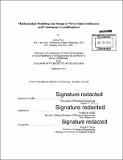Mathematical modeling and design of novel semi-continuous and continuous crystallizations
Author(s)
Zhou, Lifang, Ph. D. Massachusetts Institute of Technology
DownloadFull printable version (16.51Mb)
Other Contributors
Massachusetts Institute of Technology. Department of Chemical Engineering.
Advisor
Richard D. Braatz.
Terms of use
Metadata
Show full item recordAbstract
Crystallization is an important separation technology used for the purification of products during their final stages of manufacturing. Novel semi-continuous and continuous crystallization process designs are receiving increasing attention in pharmaceutical industry due to significant advantages in terms of process, operation and costs. This dissertation aims to develop mathematical models for describing three newly designed crystallization processes (semi-continuous crystallization, layer crystallization, and falling film crystallization) and examining mass and heat transport, crystal growth, and impurity migration. The first study investigates a new process for crystal size distribution (CSD) control that combines antisolvent crystallization in a dual impinging jet crystallizer with cooling crystallization in a mixing tank. This proposed semi-continuous process provides higher degrees of control of the CSD than those obtainable with past crystallizer designs. The proposed approach extends that the supersaturation is time-varying instead of specified at a constant controlled value. This study also examines the potential benefits of additional practical degrees of freedom: control of volume of the mixers, jet flow rates, jet mixing temperatures, antisolvent-solvent flow rate ratios, and supersaturation in the stirred tank. The results support the process design and motivate future experimental implementations. For the second design, a solution layer crystallization process in a concentric annulus is presented that removes the need for filtration. A dynamic model for layer crystallization with and without a recirculation loop is developed in the form of coupled partial differential equations describing the effects of mass transfer, heat transfer, and crystallization kinetics. The model predicts the variation of the temperature, concentration, and dynamic crystal thickness along the pipe length, and the concentration and temperature along the pipe radius. The model predictions are shown to closely track experimental data that were not used in the model's construction, and also compared to an analytical solution that can be used for quickly obtaining rough estimates when there is no recirculation loop. The model can be used to optimize product yield and crystal layer thickness uniformity, with constraints on the supersaturation to avoid bulk nucleation by adjusting cooling temperatures in the core and jacket. The third design is a cyclic process of falling film crystallization that combines cooling and evaporation to improve the yield and purity of host molecules in a solution. A mathematical model is developed to predict the parameters of this process at various operational conditions for separating ibuprofen from an ethanol-water mixture in the presence of impurity, ketoprofen. The distribution coefficients of ibuprofen between crystal phase and solution phase is determined. The numerical results are compared to experimental values to validate the model and the model predicts concentration and crystal layer thickness from different conditions.
Description
Thesis: Ph. D., Massachusetts Institute of Technology, Department of Chemical Engineering, 2014. Cataloged from PDF version of thesis. Includes bibliographical references.
Date issued
2014Department
Massachusetts Institute of Technology. Department of Chemical EngineeringPublisher
Massachusetts Institute of Technology
Keywords
Chemical Engineering.